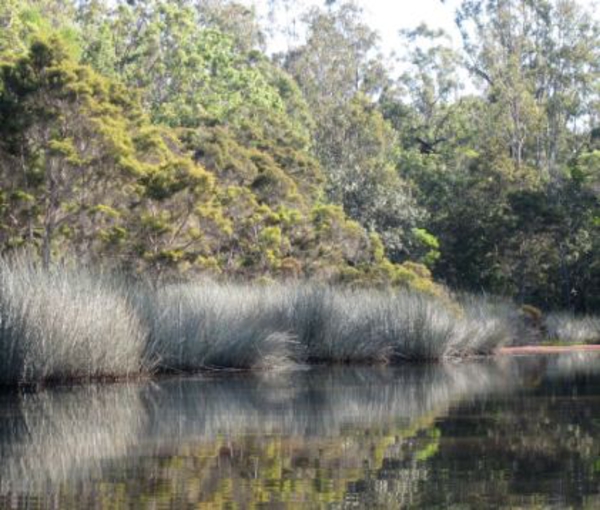Kewilpa Kewilpa is an iconic 832 hectare property in the Bungawalbin area of northeastern NSW near Casino. The property supports eight vegetation communities, six of which are recognised as endangered ecological communities. South Endeavour purchased Kewilpa in 2009 in order to ensure the long term protection of its unique ecological values. Kewilpa is home to 185 plant species and 11 threatened animal species, including an endangered emu population in the NSW North Coast bioregion. The property is bordered by creeks with numerous spring-fed ponds and features two large lagoons. The nature conservation values of Kewilpa include the following:Six Endangered Ecological Communities: - ‘Lowland rainforest on floodplain in the NSW North Coast and Sydney Basin Bioregion’ occurs as rainforest dominated by Weeping Lillypilly Syzygium floribundum and Water Gum Tristaniopsis laurina along riparian areas on the main creek systems.
- ‘Subtropical Coastal Floodplain Forest of the NSW North Coast Bioregion’ occurs as the Red Gum dominated forest ecosystems.
- ‘Swamp Sclerophyll Forest on Coastal Floodplain of the NSW North Coast, Sydney Basin and South East Corner Bioregions’ is found along wet, poorly drained areas comprising Tea Tree Melaleuca alternifolia and Swamp Box Lophostemon suaveolens.
- ‘Swamp Oak Floodplain Forest of the NSW North Coast, Sydney Basin and South East Corner Bioregions’ occurs in two small stands towards the centre of the Conservation Area.
- ‘Freshwater wetlands on Coastal Floodplain of the NSW North Coast’ occurs in back‐ swamps, lagoons and drainage lines which support open permanent standing water and periodic inundation of freshwater.
- ‘Coastal Cypress Pine Forest in the NSW North Coast Bioregion.’ This occurs as a distinct community on the western portion of the Land.
Two threatened flora species. These are: - Green‐leaved Rose Walnut ‐ Endiandra muelleri subsp. bracteata (e),
- Slaty Red Gum ‐ Eucalyptus glaucina (v, V).
Note: (v) = listed as Vulnerable or (e) = Endangered under the TSC Act, (V) = listed as Vulnerable or (E) = Endangered under the EPBC Act. Habitat for at least another 17 threatened flora species. These are: - Sweet Myrtle ‐ Gossia fragrantissima (e, E),
- Slender Screw Fern ‐ Lindsaea incisa (e),
- Hairy melichrus ‐ Melichrus hirsutus (e, E),
- Narrow‐leaved Melichrus ‐ Melichrus sp. Gibberagee (e,E),
- Water Nutgrass ‐ Cyperus aquatilis (e),
- Sweet False Galium ‐ Hedyotis galioides (e),
- Native Milkwort ‐ Polygala linarifolia (e),
- Axe Breaker ‐ Geijera paniculata (e),
- Ripple‐leaf Muttonwood ‐ Rapanea sp.A Richmond River (e, E),
- Weeping Paperbark ‐ Melaleuca irbyana (e),
- Square‐stemmed Spike‐rush ‐ Eleocharis tetraquetra (e),
- Tall Knotweed ‐ Persicaria elatior (v, V),
- Brush Sauropus ‐ Phyllanthus microcladus (e),
- Brown Fairy‐chain Orchid ‐ Peristeranthus hillii (v),
- Yellow‐flowered King of the Fairies ‐ Oberonia complantana (e),
- Square‐fruited Ironbark ‐ Eucalyptus tetrapleura (v, V) and
- Thorny Pea ‐ Desmodium acanthocladum (v, V).
Eleven threatened fauna species and one threatened population. These are: - Giant Barred Frog Mixophyes iteratus (e, E),
- Glossy Black ‐ cockatoo Calyptorhynchus lathami (v),
- Powerful Owl Ninox strenua (v),
- Masked Owl Tyto novaehollandiae (v),
- Wompoo Fruit‐dove Ptilinopus magnificus (v),
- Red‐backed Button‐quail Turnix maculosa (v),
- Brush‐tailed Phascogale Phascogale tapoatafa (v),
- Koala Phascolarctos cinereus (v),
- Yellow‐bellied Glider Petaurus australis (v),
- Squirrel Glider Petaurus norfolcensis (v),
- Grey‐headed Flying Fox Pteropus poliocephalus (v, V), and
- The Endangered Emu Dromaius novaehollandiae population in the NSW North Coast ‘Bioregion and Port Stevens Local Government Area’ (e).
Potential habitat for additional sedentary and nomadic species including at least 17 birds, 1 amphibian, 5 terrestrial or semi‐ arboreal mammals, 1 mega‐chiropteran bat, 5 micro‐chiropteran bats and at least 3 reptiles. |
